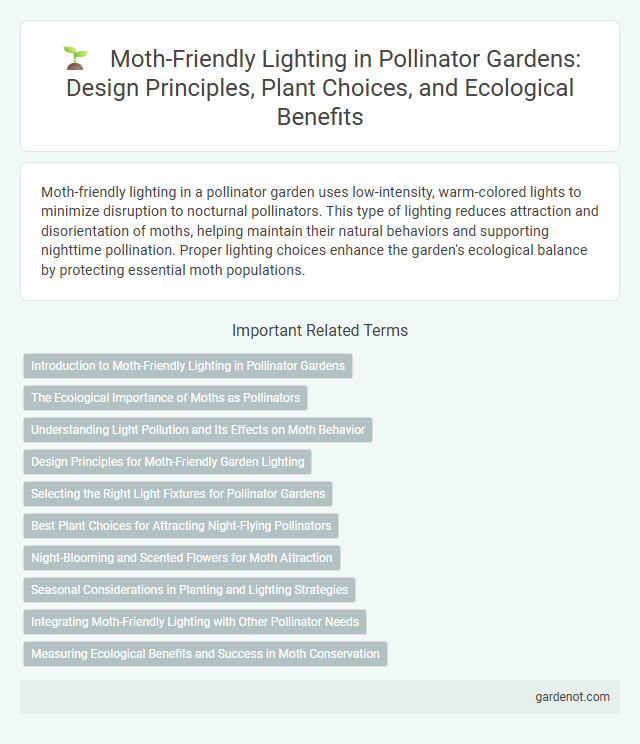Moth-friendly lighting in a pollinator garden uses low-intensity, warm-colored lights to minimize disruption to nocturnal pollinators. This type of lighting reduces attraction and disorientation of moths, helping maintain their natural behaviors and supporting nighttime pollination. Proper lighting choices enhance the garden's ecological balance by protecting essential moth populations.
Introduction to Moth-Friendly Lighting in Pollinator Gardens
Moth-friendly lighting in pollinator gardens minimizes blue and ultraviolet light emissions to reduce disruption of nocturnal pollinators' natural behaviors. Using warm-colored, low-intensity lights enhances moth activity and supports their role in pollination without attracting excessive predators. Selecting energy-efficient, amber LED bulbs specifically designed for moth habitats helps maintain garden biodiversity and promotes healthier nighttime ecosystems.
The Ecological Importance of Moths as Pollinators
Moths serve as vital nocturnal pollinators, contributing significantly to the reproduction of many plant species, especially those with night-blooming flowers. Their interaction with diverse floral resources supports ecosystem health and biodiversity, making moth-friendly lighting essential to minimize disruption of their natural behaviors. Implementing low-intensity, warm-colored lights in pollinator gardens helps preserve moth populations and ensures continued pollination services critical for ecological balance.
Understanding Light Pollution and Its Effects on Moth Behavior
Moth-friendly lighting reduces light pollution by using low-intensity, warm-colored bulbs that minimize disruption to nocturnal pollinators. Excessive artificial light alters moth navigation, feeding, and mating behaviors, significantly decreasing their pollination efficiency. Implementing dim, shielded, and motion-activated lighting supports moth populations and enhances the ecological balance within pollinator gardens.
Design Principles for Moth-Friendly Garden Lighting
Design principles for moth-friendly garden lighting emphasize low-intensity, warm-spectrum bulbs to minimize disruption to nocturnal pollinators. Utilizing shielded fixtures directs light downward, reducing skyglow and preserving natural moth navigation cues. Incorporating motion sensors and timers limits light exposure duration, supporting the ecological balance in pollinator gardens.
Selecting the Right Light Fixtures for Pollinator Gardens
Choosing the right light fixtures for pollinator gardens involves selecting moth-friendly options that minimize disruption to nocturnal pollinators. LED lights with warm color temperatures (2700K-3000K) and low UV emissions reduce attraction and harm to moths, supporting their natural behaviors. Shielded fixtures that direct light downward further protect moth activity by preventing light spill and preserving the garden's ecological balance.
Best Plant Choices for Attracting Night-Flying Pollinators
Night-blooming plants such as Evening Primrose, Moonflower, and Nicotiana are ideal for attracting moths, key nocturnal pollinators drawn by their fragrant, pale-colored flowers. These species thrive in low-light conditions and emit strong scents that guide moths to nectar sources. Incorporating native, wheatgrass-like sedges also supports moth populations by providing larval host plants essential for their life cycle.
Night-Blooming and Scented Flowers for Moth Attraction
Night-blooming and scented flowers such as evening primrose, moonflower, and jasmine are essential for attracting moths to a pollinator garden, providing nectar during nighttime hours. Moth-friendly lighting uses low-intensity, amber or red LED lights to minimize disruption of moth navigation and behavior while enhancing nocturnal pollination activities. Strategic placement of these lights away from floral clusters helps preserve natural moth patterns and supports biodiversity in moth populations.
Seasonal Considerations in Planting and Lighting Strategies
Selecting native, night-blooming plants such as evening primrose and jasmine enhances moth attraction during peak activity seasons, primarily late spring through early fall. Using amber or red spectrum LED lights minimizes disruption to moth navigation and feeding behaviors while supporting nocturnal pollination. Strategic placement of lighting away from key flowering areas reduces light pollution, preserving natural moth foraging patterns across seasonal cycles.
Integrating Moth-Friendly Lighting with Other Pollinator Needs
Moth-friendly lighting minimizes disruptive blue and UV wavelengths, promoting natural nighttime pollination behaviors crucial for nocturnal pollinators. Integrating low-intensity, amber-hued lights around nectar-rich plants supports moth activity while preserving the ecosystem balance. This lighting approach complements habitat features like native flowering species and water sources, enhancing overall pollinator garden effectiveness.
Measuring Ecological Benefits and Success in Moth Conservation
Moth-friendly lighting reduces artificial light pollution, supporting nocturnal pollinator activity and enhancing biodiversity in pollinator gardens. Measuring ecological benefits involves monitoring moth population diversity, abundance, and behavioral changes using light traps and ecological surveys. Success in moth conservation is evaluated through increased moth visitation rates to native plants and improved pollination metrics.
Moth-friendly lighting Infographic

 gardenot.com
gardenot.com